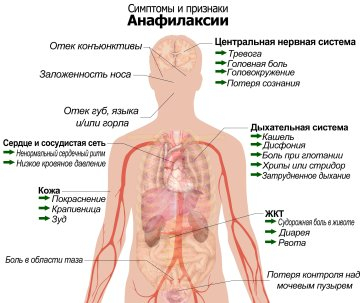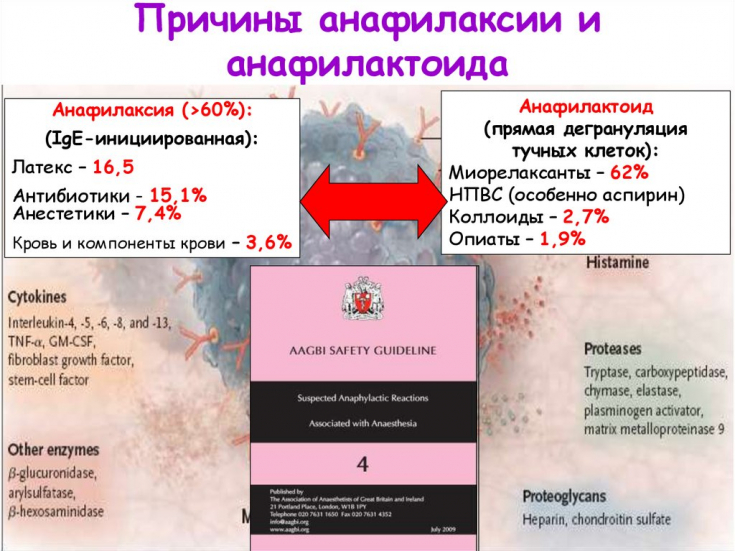Anaphylaxis − it is a severe, life-threatening, systemic hypersensitivity reaction (allergic or non-allergic). Hypersensitivity − it is the presence of objective and subjective symptoms that recur as a result of exposure to a particular irritant at a dose that is normally tolerated by a healthy person.
Find out in the article on estet-portal.com how a cosmetologist can recognize the symptoms of anaphylaxis and what are the rules of medical care for this condition.
- How can a cosmetic doctor recognize the symptoms of anaphylaxis
- Anaphylaxis: principles of treatment
- Peculiarities in the use of epinephrine in anaphylaxis
- Anaphylaxis: blood pressure support
- Use of corticosteroids and antihistamines for anaphylaxis
How can a beautician recognize the symptoms of anaphylaxis
The clinical picture of anaphylaxis is very variable. Skin and mucosal involvement is almost always noted: more than 90% of patients with anaphylaxis may develop urticaria, erythema, pruritus, or angioedema.
Follow us on Instagram!
Upper airway involvement is clinically manifested by nasal congestion and sneezing. Bilateral conjunctivitis may occur. Cough, hoarseness, or a feeling of a foreign body in the throat indicates airway obstruction. Inspiratory stridor − the most threatening symptom of upper airway obstruction.
Ways to overcome toxic skin reactions in the practice of a dermatologist

Chest pain may result from bronchospasm or myocardial ischemia (secondary to hypoxia and hypotension). Hypoxia and hypotension lead to a feeling of general weakness, dizziness and fainting. In general, most patients with anaphylaxis initially report a feeling of fear of death, itching and flushing.
Subsequently, the following symptoms may develop:
1. From the side of the skin – skin itching, urticaria, conjunctival pruritus, angioedema.
2. From the side of the respiratory system − wheezing, shortness of breath, cough, nasal congestion.
3. From the CCC – weakness, dizziness, pressure drop, fainting, possible palpitations.
4. Gastrointestinal − nausea, possible vomiting.
5. Nervous system − dizziness, headache, possibly impaired pupillary response.
What a dermatologist should know about hives in children

The above symptoms occur within 5-30 minutes of exposure to the allergen, but in some cases they can develop instantly or within a few seconds, so first aid drugs for anaphylaxis should always be in the first aid kit of a cosmetologist.
The faster anaphylaxis develops after exposure to an allergen, the the more severe it is.
Anaphylaxis: principles of treatment
Anaphylaxis − it is an acute life-threatening condition that requires immediate recognition and treatment. Pre-hospital care for patients with severe anaphylaxis includes provision of venous access, oxygen therapy, cardiac and respiratory monitoring.
Toxicoderma: causes, symptoms, diagnosis, treatment

For its part, the cosmetologist may place the patient in a horizontal position with legs elevated (anti-shock position, or Trendelenburg position), unless there is vomiting. If necessary, artificial ventilation of the lungs should be provided. In extreme situations cricothyrotomy is indicated.
Peculiarities of the use of epinephrine in anaphylaxis
Epinephrine (adrenaline) − the drug of choice in the treatment of patients with severe anaphylaxis, helps maintain blood pressure levels. Delay in the administration of epinephrine to patients with anaphylaxis is associated with high mortality. There are no absolute contraindications to the use of epinephrine in patients with anaphylaxis.
It is necessary to provide immediate intramuscular epinephrine in the anterolateral thigh area at a dose of 0.3 mg (in the form of a solution of 1: 1000) for adults and 0.01 mg / kg of body weight (in the form of a solution of 1:10,000) & minus; for kids. If necessary, repeated adrenaline injections can be given every 5-15 minutes.
Five skin manifestations that can save lives if diagnosed
Racemic epinephrine (aerosolized adrenaline) may be used to reduce swelling in the throat, but does not replace adrenaline injections. In patients with coronary heart disease, the use of adrenaline can lead to an exacerbation of ischemia, so the cosmetologist, when working with this group of patients, must take responsibility for collecting allergological history.
Anaphylaxis: blood pressure support
Despite the rare development of this condition in aesthetic medicine, the cosmetologist must remember that maintaining an adequate blood pressure − an important aspect of the management of patients with anaphylaxis. Since hypotension is due to the loss of circulating blood volume, in anaphylaxis, in addition to injections of adrenaline, aggressive infusion of large volumes of fluids is indicated (in some cases, the administration of more than 5 liters of crystalloids may be required).
Allergy to Latex – who is at risk of a pathological reaction to an allergen
On average, to adequately compensate for intravascular fluid volume, adults should inject 1-2 L of saline intravenously at a rate of 5-10 ml/kg over the first 5 minutes .
Use of corticosteroids and antihistamines for anaphylaxis
Standard treatment for anaphylaxis also includes antihistamines and corticosteroids. Despite the slow onset of action of antihistamines, they should be used in addition to adrenaline injections, but in no case should they be replaced. The introduction of antihistamines should not delay the use of epinephrine. To alleviate histamine-mediated symptoms, the use of a combination of H1 and H2 histamine blockers (diphenhydramine and ranitidine) is effective. The combination of drugs is more effective than the isolated use of H1 or H2 histamine blockers.
Corticosteroids (prednisolone at a dose of 1 mg/kg/day) do not play a significant role in the treatment of patients with anaphylaxis, but their use is advisable in order to prevent the development of a biphasic reaction. Most patients who used antihistamines and corticosteroids for anaphylaxis subsequently had a complete remission.
Preventing a recurrence of an anaphylaxis episode is to identify the causative allergen and avoid future exposure to it.
Erythema multiforme exudative: features of the course of dermatosis







Add a comment